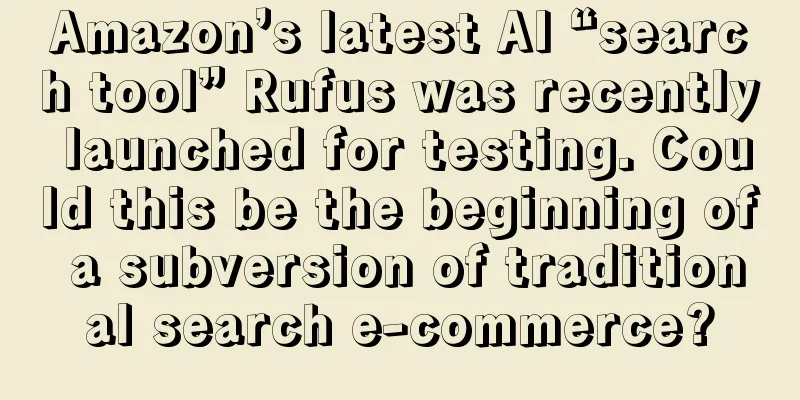|
This article will be divided into four modules:
Preface : In what ways has the AI wave affected cross-border e-commerce in the past year or so? Where does Rufus’ training content come from – what are the possible impacts on sellers’ expectations? Thoughts on possible responses at this stage - What can you as a seller/operator expect to do? Conclusion
1. Introduction
2023 is the year of AI explosion. There are two main types of things that various industries do around AI applications:
1. Enterprises build their own large language models - basically only large companies have the conditions to operate.
2. Create your own small model logic algorithm application under the big language framework - business model + algorithm support, and then use it for your own company to improve business efficiency; or provide customized AI services to other companies. Some listed companies in the cross-border e-commerce industry are already doing this, and some third-party service providers/tool plug-in providers serving sellers are also providing related marketing services.
In May 2023, I attended the AIGC hosted by Zhiwubuyan in Qianhai, Shenzhen. Technology Conference
At the conference, I met many other speakers who were in charge of technology, programming, selling, and third-party cross-border customized programs. They provided many cases and knowledge about the combination of AI functions and cross-border e-commerce. This included exchanges with peers over the past six months, AI applications within the company, etc. To sum up these events, for the cross-border e-commerce industry, it can be said that most of the current AI application types are concentrated in:
Generate text content with the help of AI. Use chat GPT and other AI tools to conduct data investigation and summarize market information. With the help of AI for image/video/audio generation and optimization, the video output effect of the latest Sora has shocked the entire industry. The technology iteration and update is too fast, and the future is really difficult to define.
(The main contents are listed here. If there are other contents, you are welcome to add them.)
These contents have more impact on the application at the production tool level, and have more indirect impact on our sellers/operators.
——It was not until recently that Amazon officially launched an AI tool - Rufus - that people felt that the impact of AI on Amazon's operations or traditional e-commerce operations in the future may be more profound.
In fact, Amazon has launched three types of AI functions since 2023, and sellers are no strangers to them, including:
AI-generated review highlights Fit Review Highlights feature (AI clothing fitting function) Generative AI to make product listings even more informative for customers (AI link writing tool)
These three types of tools have a more obvious impact on the conversion rate level, but have not directly affected the "traffic" level that our sellers really care about, because Amazon is still a search e-commerce platform, and Amazon buyers still find their needs through keyword searches, that is, search traffic is still Amazon's main type of traffic.
But it was not until around February 2024, before the Spring Festival, that Amazon announced the launch of Rufus in the US, a shopping tool that uses generative artificial intelligence to help users search for products, directly embedded in the Amazon app (not yet available on the web). After carefully understanding the application scenarios and functional support of Rufus, perhaps you can foresee that the future platform traffic pattern and the way buyers search for products will be gradually affected and changed?
2. Where does Rufus’ training content come from and what impact may it have on sellers?
Rufus is actually the nickname of a pet "Corgi". Amazon has many dogs. When you link to a dog, the dog's appearance will be any dog from Amazon....
Amazon explains the source of training content and output results of the AI tool Rufus as follows:
"Rufus trained on Amazon's extensive product catalog, customer reviews, community Q&As, and information from across the web to answer customer questions on a variety of shopping needs and products, provide comparisons, and make recommendations based on conversational context."
Translation summary into vernacular:
Rufus' training content comes from: Amazon category nodes, review content, Q&A, and network information
Rufus' content output results: product comparison suggestions, suggestions based on language environment, and product recommendations that meet needs.
For example, if an Amazon buyer wants to buy a pair of headphones, in addition to entering keywords in the search box to find and learn about the product, in the future Amazon buyers may also use Rufus to ask the following questions:
What functions and parameters should be considered when buying headphones? ——Product research at the buyer level replaces the previous shopping cart add-to-cart comparison operation.
Which headphones are suitable for outdoor sports hiking? - Recommended content based on usage, scenarios, and events.
What is the difference between active noise reduction and passive noise reduction headphones? ——Content recommendations generated based on comparisons of similar products.
What are the best holiday gifts for Thanksgiving? - Content recommendations based on themes, holidays and purposes.
What are the entry-level headphones? What are the headphones with stronger bass? ——Content recommendations based on product details.
As shown in the figure below, Amazon has already started testing this feature for some buyers on its own platform. The search box not only has a search prompt, but also a ask a question prompt (Rufus question entry).
This application scenario in which buyers use this AI content interaction method to find product needs has, to a certain extent, subverted the operating logic and traffic model of traditional search e-commerce.
You should know that in the past, most of our Amazon operations, including search SEO, were based on search terms. This is determined by the nature of search e-commerce platforms/search engines. When users have a shopping need in their minds, their first reaction in most cases is to go to the Amazon platform search box, enter relevant keywords, and view the corresponding link information. The "search term" is the source of traffic, that is, the label for dividing the population.
Then, with the accumulation of a large amount of buyer search behavior data, Amazon provides us sellers with popular search term data - search volume, search popularity ranking, and the operation is equivalent to using the search term popularity data to determine which search terms buyers will associate and use more frequently in a certain market segment, and then focus on promoting their own link products to such terms (advertising ranking + natural search ranking). This is the main logic of Amazon's current operation and promotion (only in terms of on-site traffic). Regardless of black or white hat, they mainly follow this keyword ranking display logic.
However, the emergence of Rufus means that in the future, Amazon buyers will have an additional window for AI content interaction to find products, in addition to entering keywords in the search box on the homepage to find products. In other words, in the past traffic structure of the Amazon platform, in addition to the main traffic type of search traffic, there will be an additional traffic entrance for Rufus AI content questioning and recommendation display.
As for whether or how long it will take for Rufus' traffic share to be comparable to search traffic, the current expectations mainly depend on two aspects:
The development level of AI e-commerce is that Alibaba's "Xingchen" in China and Amazon's Rufus abroad are both in the initial stage. Alibaba has regarded AI e-commerce as an important strategy for the future. It is said that this is Alibaba's "core weapon" to suppress Duoduo in the future. Consumers' acceptance of AI tools is also closely related to the former.
As Tik Tok currently After this short video platform launched Tik Tok shop, some local American users believed that this destroyed the fun of the short video platform (filled with advertisements and product marketing), but objectively it could not stop the performance growth of Tik Tok shop.
From Internet e-commerce to mobile e-commerce, and then to today's short video/live streaming/social e-commerce, when a new model emerges, user acceptance and corporate education actually influence each other.
For buyers, purchasing behavior may gradually change from simply "entering keywords to search" to "asking questions to Rufus to learn about recommended product information." For sellers, the main traffic "search traffic" in the past may gradually be transferred to Rufus.
If you want your product information to appear in AI content recommendations, relying solely on natural ranking by stacking search terms is not enough according to the expected Rufus crawling logic.
3. Thinking about the possible responses at this stage
If we discuss according to the current application definition of Rufus, in order for a product to obtain and increase the number of impressions on Rufus, the requirements for the richness and relevance of the link content will be greatly improved.
Because our past search e-commerce thinking was: the title, five points, and description focused on popular words and related popular words (long-tail words of big words) to serve the purpose of search word promotion.
Rufus has redefined this operational concept to a certain extent. If we used to analyze "what words buyers would search for" to write link content, in the future we may need to think about "how would buyers ask Rufus questions?" What purposes, scenarios, uses, and usage details will buyers use to ask Rufus questions?
The official sources of Rufus content training are as follows:
Amazon category node. This is basically fixed, and is basically derived from category node + product type. There is not much room for expansion. At most, you can set up multiple category nodes, but sellers who have operated it know that it is difficult to maintain it in the long term.
Review content. If you are a seller who does reviews, you can plan your review content around the features of Rufus. If you are a merged seller (zombie or mirror), if the review content does not match the product, it is possible that the product will be wrongly recommended.
Q&A, which is currently hidden in the front desk, but buyers can still ask questions, that is, the buyer's questions and the seller's reply information will be included in the training model of Rufus. Combining the behavior of Rufus and the phenomenon of Q&A being hidden, it is possible that Amazon is afraid of being anti-crawler, so it hides the front desk Q&A information. However, the Q&A information of buyers' questions can still be seen in the store registration email, and the competitor's Q&A currently exported through third-party tools is only the recent content. Or change the asin at www.amazon.com/ask/questions/asin/ASIN to view QA.
Network information is more intriguing. The official text is: "information from across the web", which means that web information inside and outside the site may be crawled into Rufus' training model.
For the site:
In addition to the three points mentioned above, listing information can appear in the following places in the text box:
A. Titles are limited in length. To deal with Rufus, we need to simplify the information such as scene words, purpose, theme festival, parameter function, and select certain words to embed. In the past, many sellers would write titles just to embed words, and the richness of the product content was secondary consideration.
B. Five points. Similar to the title elements, but with more expansive content. The interpretation of scenarios, uses, theme festivals, parameter functions, product usage details, etc. can be broader, but the content should not be forced, which affects readability and difficulty in understanding the product.
C. Description can be used as content that is difficult to embed in the five points, because this content may not be directly displayed on the front page, so if you guess how your product may be asked through Rufus, you can embed the corresponding content. For example: the most suitable gift for Thanksgiving, the ideal outdoor sports equipment, headphones with very shocking bass effects, etc....
D. A+ text box . In addition to the text box that comes with the general image module, do you still remember that there is a "Q&A module" in the advanced A+? There is also a Q&A content setting in the brand story. Isn't this the most suitable way to move all the Q&A content that buyers may be involved in Rufus, reflect it in the link copy, and promote inclusion?
For outside the site:
SEO articles, blogs on independent websites, social media posts, etc. These contents that are highly related to the characteristics of linked products, directly or indirectly, may be included in Rufus' training content. This reminds me of a sentence mentioned by a speaker at the last AIGC conference. I can't remember the original words, but the general meaning is: "The purpose of writing these contents for SEO promotion is that although the effect cannot be seen directly, if a consumer uses Chat GPT one day, When you ask questions about the type of product you sell, your brand name may appear in the content recommendations output by GPT." When I heard this content on the spot, I thought the idea was quite novel. Just over half a year later, Amazon's Rufus tried to launch a test of this idea.
I can't help but think of a saying that was circulated in the SEO promotion industry before: "Search SEO is dead, semantic SEO should be established"
In general, it is expected that people who "have purchasing needs but unclear needs" will be more likely to use Rufus, and they will use Rufus to find product information that meets the details of their needs.
That is, for sellers at this stage, Rufus may be able to directly meet the needs of acquiring potential and marginal traffic. For this group of people hovering on the marginal traffic, it was difficult for us sellers to directly gain exposure to these people by relying solely on long-tail words in the past (broad/phrase matching is more of an indirect exposure, and the buyer’s actual demand search terms may not match our delivery terms). Now Rufus provides buyers with content interaction, so that they no longer rely on long-tail words that are difficult to guess to search for products, but instead make recommendations through semantic understanding.
4. Conclusion
From web search e-commerce to mobile search e-commerce, social marketing e-commerce, short video content e-commerce, and now AI e-commerce, every change in form brings new opportunities.
In general, Rufus has just been launched and is still in the beta stage. It remains to be determined how far it will evolve. Amazon has already provided beta services to a small number of buyers and will gradually promote it to more American buyers in the future.
Will Rufus eventually become a tool frequently used by buyers on Amazon and an important traffic channel for sellers? Will it ... It has become useless. We still need to wait and see at this stage, waiting for time and data accumulation to verify it.
Just as in the first quarter of 2022, when Amazon officially announced the platform's APP traffic and web traffic separately for the first time and displayed them to sellers, it shocked everyone - it turned out that the sessions they had seen before only came from web channels, and the conversion rates were all inflated, forcing everyone to pay attention to and adjust the content layout and operation strategies of the APP pages. It also means that the development of mobile e-commerce in the US market is becoming more and more obvious (the development speed of mobile e-commerce in the United States is slower than that in China).
Perhaps in one or two years, when Amazon releases Rufus' traffic data, and you discover the proportion of traffic data from Rufus in your store and your link traffic data, you will be forced to make adjustments in this regard. By that time, I believe that the operational methods for Rufus will be more diverse.
|










